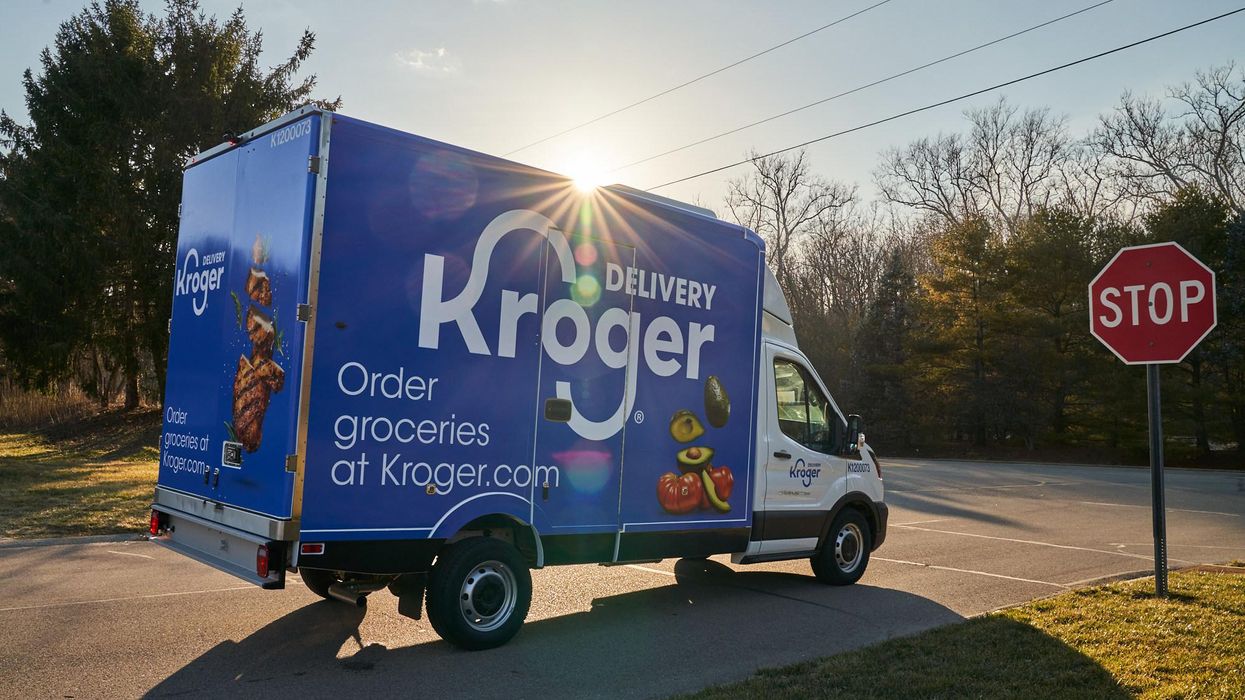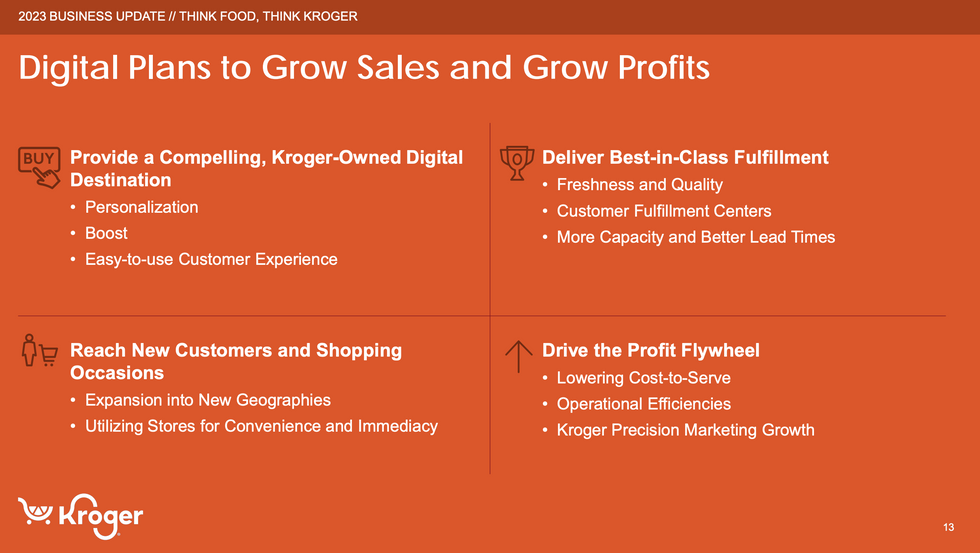Retail Channels
02 March 2023
Kroger's 4 pillars of ecommerce growth
With an eye on profitability, the grocer sees double digit growth continuing in digital for the next 3 years.

Kroger is eying ecommerce profitability. (Courtesy photo)
With an eye on profitability, the grocer sees double digit growth continuing in digital for the next 3 years.

Kroger is eying ecommerce profitability. (Courtesy photo)
Kroger saw digital growth outpace overall sales figures in the final quarter of 2022, while the grocer’s costs associated with ecommerce came down amid an expansion of fulfillment capabilities.
Kroger released the following data on digital sales for the fourth quarter of 2022:

(via Kroger)
Coming out of the pandemic, Kroger is continuing to expand ecommerce as part of an omnichannel offering that crosses both stores and online channels. Over the next three years, CEO Rodney McMullen told analysts during an earning call Thursday that the company is expecting digital sales growth to continue to reside in the double digits, and outpace overall sales growth.
“Despite the easing of pandemic-related shopping behaviors that led to a significant increase in online shopping, more and more customers are incorporating ecommerce into their daily permanent routines, recognizing the value and convenience online shopping offers,” McMullen said.
In ecommerce, Kroger is focused on four key areas to continue to drive growth:
A digital destination. When shoppers visit the grocer's online marketplace, Kroger’s ecommerce shopping experience must deliver “value, personalization and freshness in a single, easy-to-use online experience," McMullen said.
Delivery. Kroger leverages a store network that has proximity to many customers, and fulfillment centers where large orders can be prepared. It recently added to the fulfillment network with a new center in the Denver area. Delivery customers spend more with Kroger overall, so excelling in this area drives the entire business.
"If you look, what we find is a customer, when they move online, they actually after a year engage with us more in store than before,” McMullen said. “So what we're really focused on is having an ecosystem where the customer thinks food, they think Kroger. And what we're finding is the customer routinely moves back and forth between the different channels.”
New customers and more orders. With delivery, Kroger sees opportunity to grow the share of wallet that customers spend. This can come through increasing the number of orders that customers place. This is why 30-minute delivery service Kroger Delivery Now is an important part of the equation.
Profitability. Kroger is looking to drive down its costs for ecommerce, and made progress in the fourth quarter. It was the best-ever quarter for the cost-to-serve a digital order as the company seeks to lower fulfillment costs and build more density in demand and last-mile routing. The company is also growing retail media through Kroger Precision Marketing and 84.51, which brings a profitable revenue stream. Alongside the profit listed above, the amount of media revenue Kroger generates per digital transaction is also growing.

(via Kroger)
All of this makes up a flywheel of mutually reinforcing elements that Kroger is looking to spin faster. The pending acquisition of Albertsons only figures to help, as Kroger will add that grocer's fulfillment capabilities and customer data to its media network. Here’s how CFO Gary Millerchip summed it up:
“Over recent years, we have invested significantly in our people, our customers and technology to create a leading omnichannel position in food retail. By executing our go-to-market strategy, we win customers in our core supermarket business, including health and fuel and drive significant customer traffic and data into our ecosystem. This, in turn, allows us to deploy our investments in technology and 84.51 to deliver even greater value for customers and create new high-growth, high-margin alternative profit businesses. The value generated from these businesses enables us to reinvest back into our supermarkets and drive further store and digital traffic, creating a flywheel effect.”
Campbell Soup Company CEO Mark Clouse offered thoughts on messaging amid inflationary shifts in consumer behavior.
After months of elevated inflation and interest rate hikes that have the potential to cool demand, consumers are showing more signs of shifting behavior.
It’s showing up in retail sales data, but there’s also evidence in the observations of the brands responsible for grocery store staples.
The latest example came this week from Campbell Soup Company. CEO Mark Clouse told analysts that the consumer continues to be “resilient” despite continued price increases on food, but found that “consumers are beginning to feel that pressure” as time goes on.
This shows up in the categories they are buying. Overall, Clouse said Campbell sees a shift toward shelf-stable items, and away from more expensive prepared foods.
There is also change in when they make purchases. People are buying more at the beginning of the month. That’s because they are stretching paychecks as long as possible.
These shifts change how the company is communicating with consumers.
Clouse said the changes in behavior are an opportunity to “focus on value within our messaging without necessarily having to chase pricing all the way down.”
“No question that it's important that we protect affordability and that we make that relevant in the categories that we're in," Clouse said. "But I also think there's a lot of ways to frame value in different ways, right?”
A meal cooked with condensed soup may be cheaper than picking up a frozen item or ordering out. Consumers just need a reminder. Even within Campbell’s own portfolio, the company can elevate brands that have more value now, even if they may not always get the limelight.
The open question is whether the shift in behavior will begin to show up in the results of the companies that have raised prices. Campbell’s overall net sales grew 5% for the quarter ended April 30, while gross profit margins held steady around 30%. But the category-level results were more uneven. U.S. soup sales declined 11%, though the company said that was owed to comparisons with the quarter when supply chains reopened a year ago and expressed confidence that the category is seeing a longer-term resurgence as more people cook at home following the pandemic. Snacks, which includes Goldfish and Pepperidge Farm, were up 12% And while net sales increased overall, the amount of products people are buying is declining. Volumes were down 7%.
These are trends happening across the grocery store. Campbell is continuing to compete. It is leading with iconic brands, and a host of different ways to consume them. It is following that up with innovation that makes the products stand out. Then, it is driving home messaging that shows consumers how to fit the products into their lives, and even their tightening spending plans.
Campbell Soup is more than 150 years old, and has seen plenty of difficult economic environments. It is also a different business today, and will continue to evolve. At the end of the day, continued execution is what’s required.
“If it's good food, people are going to buy it, especially if it's a great value,” Clouse said.